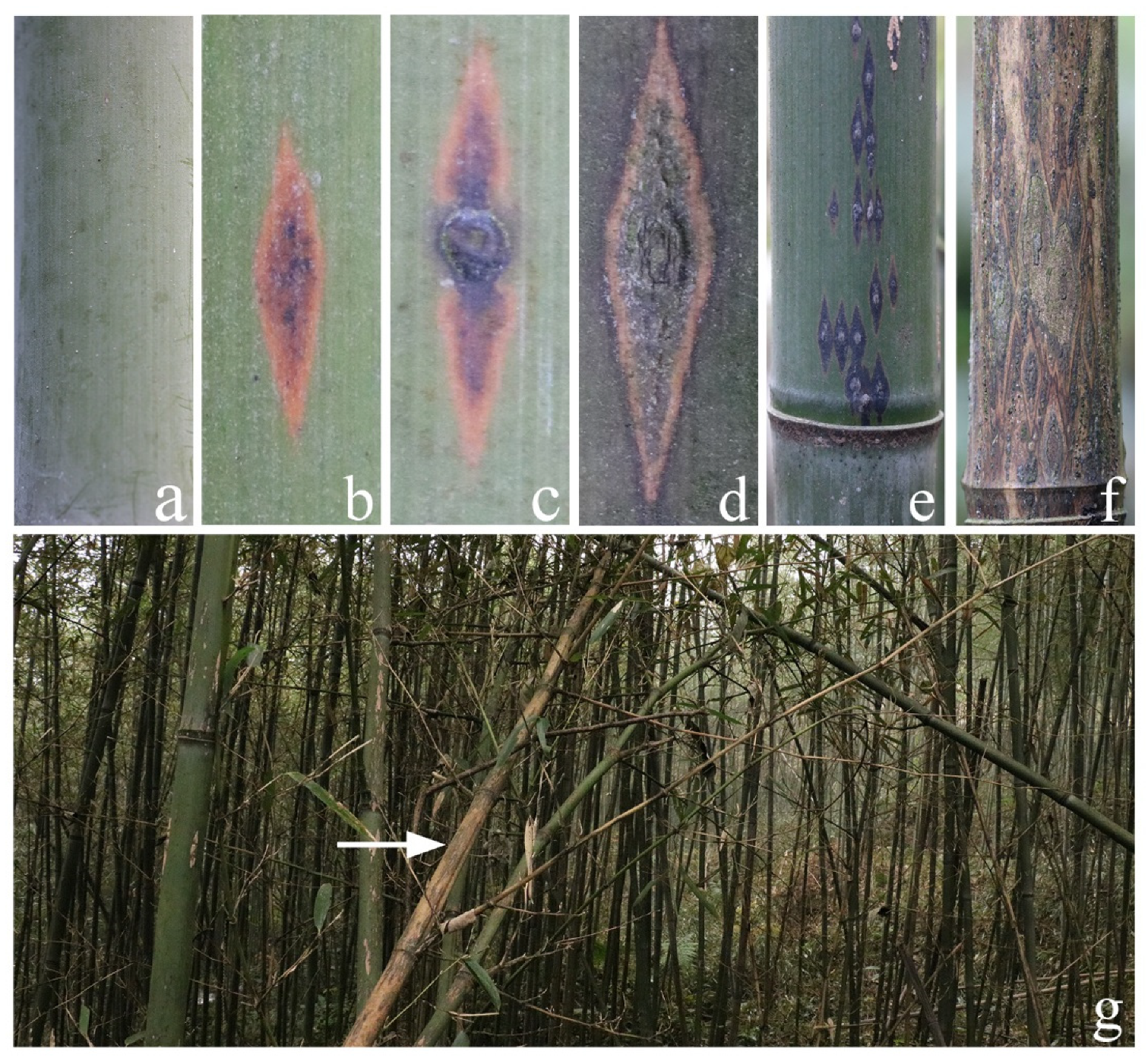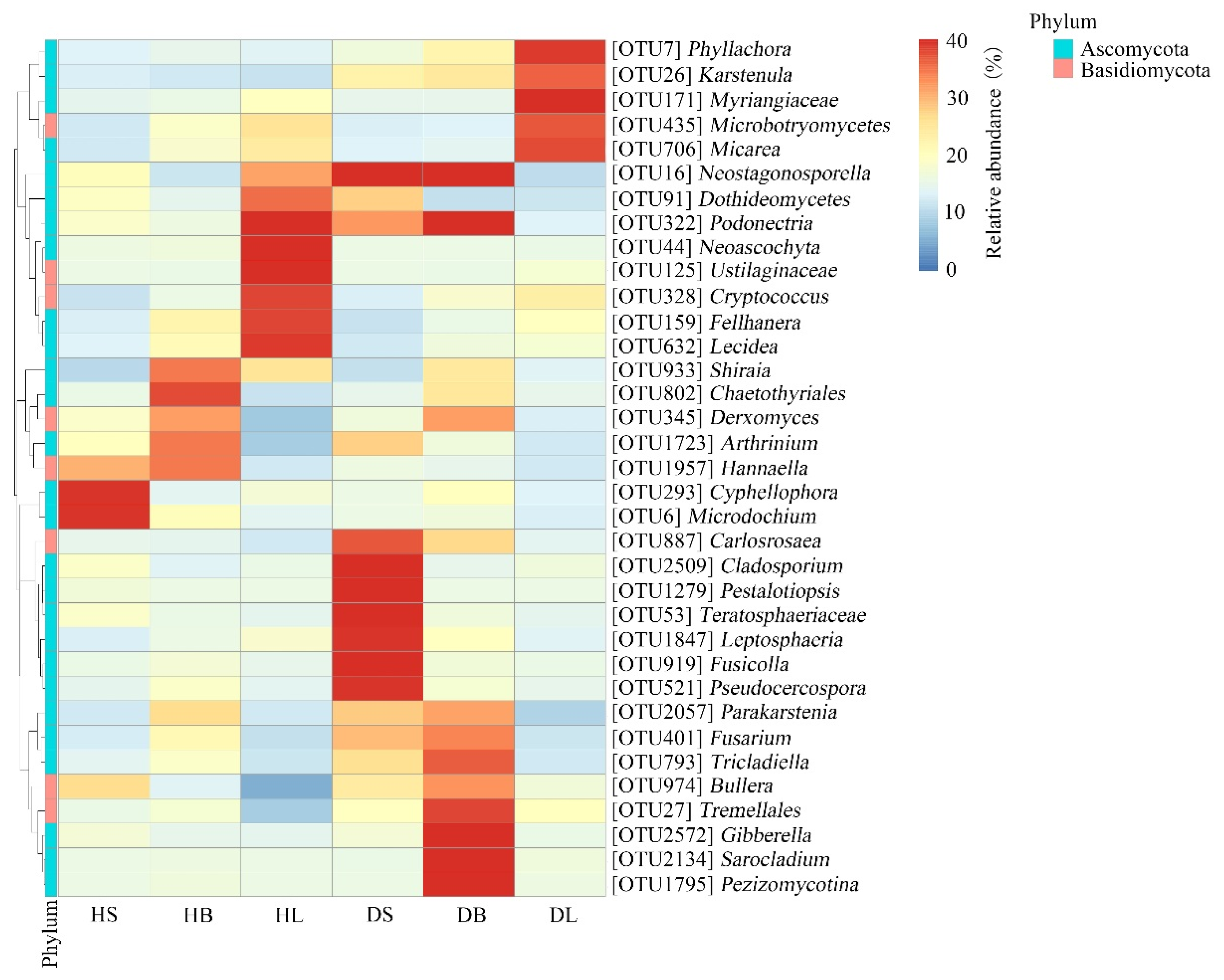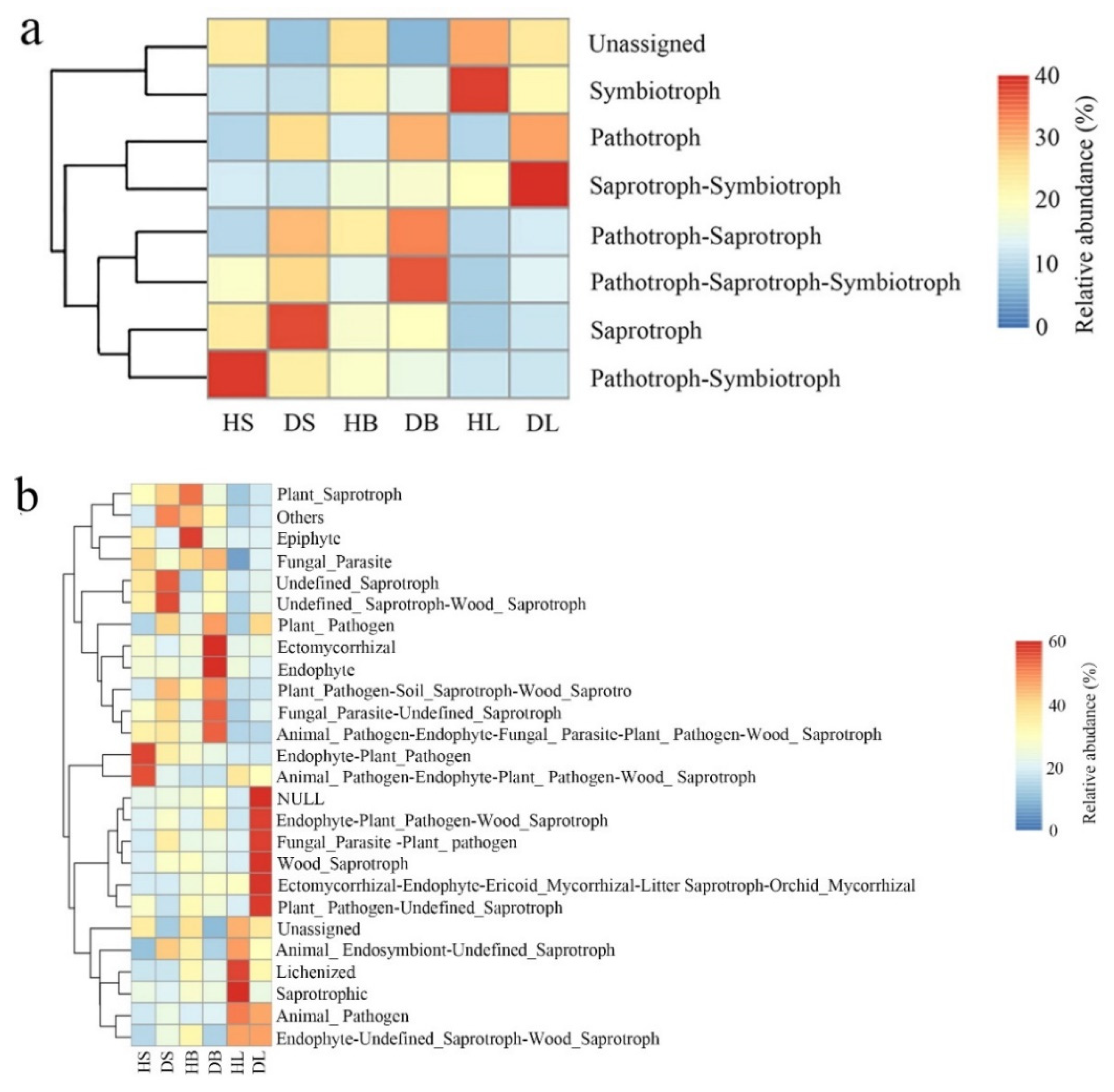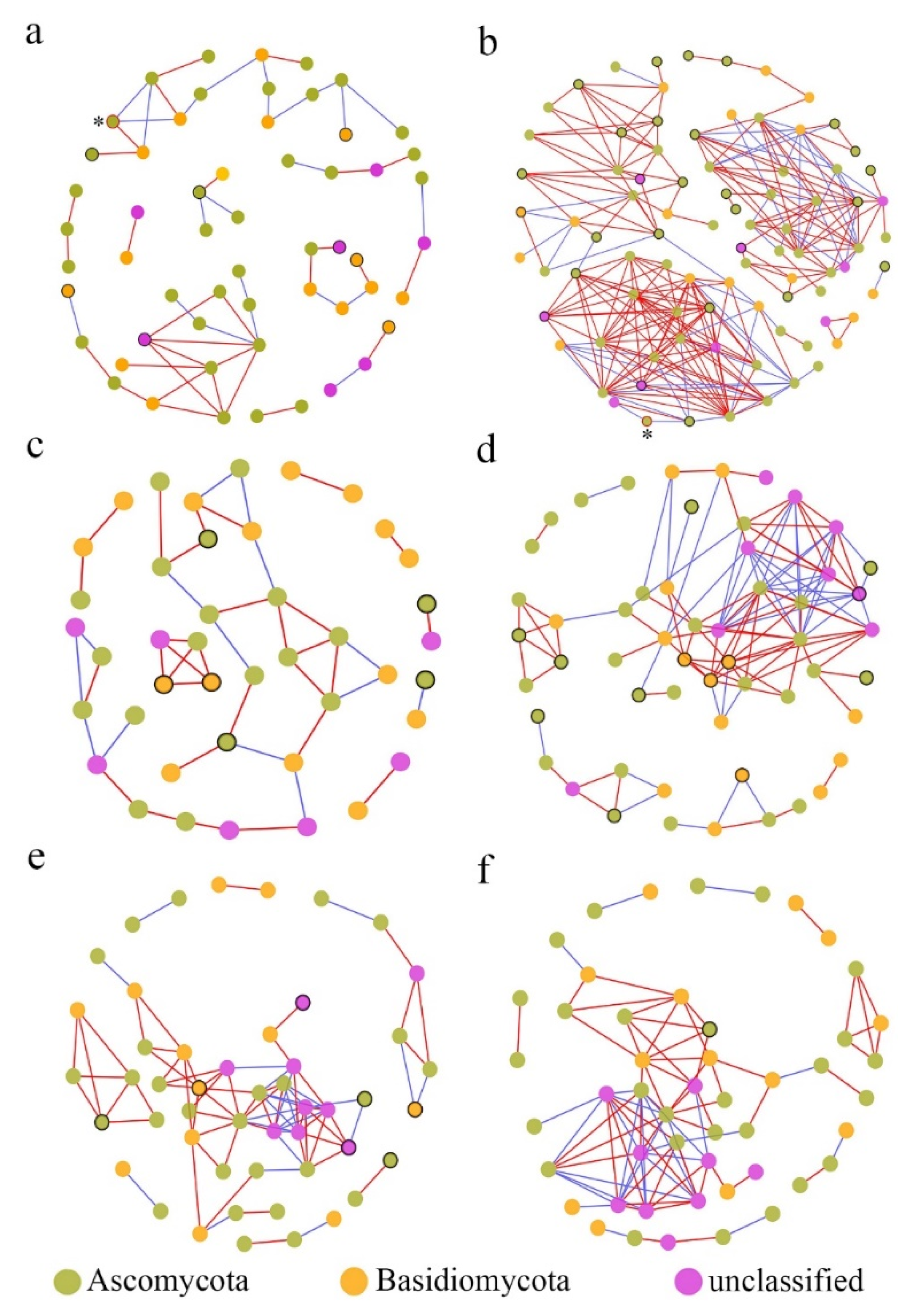Unlocking the Changes of Phyllosphere Fungal Communities of Fishscale Bamboo (Phyllostachys heteroclada) under Rhombic-Spot Disease Stressed Conditions
Abstract
:1. Introduction
2. Materials and Methods
2.1. Site Description, Sample Collection, and Processing
2.2. DNA Extraction, PCR Amplification, and Illumina Sequencing
2.3. Data Processing and Bioinformatics
2.4. Statistical Analysis
3. Results
3.1. Characterization of Illumina Sequencing Data
3.2. Effects of Rhombic-Spot Pathogen Invasion on the Phyllosphere Fungal Community Diversity and Structure of Fishscale Bamboo
3.3. Effects of Rhombic-Spot Pathogen Invasion on the Phyllosphere Fungal Community Compositions of Fishscale Bamboo
3.4. FUNGuild Analysis
3.5. The Species Associations among Fungal Communities
4. Discussion
4.1. Phyllosphere Fungal Richness, Diversity, and Community Structure of Fishscale Bamboo Stem Tissues Were Highly Changed by Rhombic-Spot Infection
4.2. Healthy and Diseased Fishscale Bamboo Harbored Distinct Phyllosphere Fungal Taxonomic and Functional Compositions
4.3. Fungal Co-Occurrence Network Characteristics Were Highly Correlated with Pathological Conditions of Fishscale Bamboo
5. Conclusions
Supplementary Materials
Author Contributions
Funding
Acknowledgments
Conflicts of Interest
References
- Liu, H.W.; Brettell, L.E.; Singh, B. Linking the phyllosphere microbiome to plant health. Trends Plant Sci. 2020, 25, 841–844. [Google Scholar] [CrossRef] [PubMed]
- Koskella, B. The phyllosphere. Curr. Biol. 2020, 30, R1143–R1146. [Google Scholar] [CrossRef] [PubMed]
- Chen, T.; Nomura, K.; Wang, X.L.; Sohrabi, R.; Xu, J.; Yao, L.Y.; Paasch, B.C.; Ma, L.; Kremer, J.; Cheng, Y.T.; et al. A plant genetic network for preventing dysbiosis in the phyllosphere. Nature 2020, 508, 7850. [Google Scholar] [CrossRef] [PubMed]
- Yao, H.; Sun, X.; He, C.; Maitra, P.; Li, X.C.; Guo, L.D. Phyllosphere epiphytic and endophytic fungal community and network structures differ in a tropical mangrove ecosystem. Microbiome 2019, 7, 57. [Google Scholar] [CrossRef] [Green Version]
- Kinkel, L.L. Microbial population dynamics on leaves. Annu. Rev. Phytopathol. 1997, 35, 327–347. [Google Scholar] [CrossRef]
- Bai, Y.; Muller, D.B.; Srinivas, G.; Garrido-Oter, R.; Potthoff, E.; Rott, M.; Dombrowski, N.; Munch, P.C.; Spaepen, S.; Remus-Emsermann, M.; et al. Functional overlap of the Arabidopsis leaf and root microbiota. Nature 2015, 528, 364–369. [Google Scholar] [CrossRef]
- Wagner, M.R.; Lundberg, D.S.; Del Rio, T.G.; Tringe, S.G.; Dangl, J.L.; Mitchell-Olds, T. Host genotype and age shape the leaf and root microbiomes of a wild perennial plant. Nat. Commun. 2016, 7, 12151. [Google Scholar] [CrossRef] [Green Version]
- Horton, M.W.; Bodenhausen, N.; Beilsmith, K.; Meng, D.Z.; Muegge, B.D.; Subramanian, S.; Vetter, M.M.; Vilhjalmsson, B.J.; Nordborg, M.; Gordon, J.I.; et al. Genome-wide association study of Arabidopsis thaliana leaf microbial community. Nat. Commun. 2014, 5, 5320. [Google Scholar] [CrossRef]
- Sapkota, R.; Jørgensen, L.N.; Nicolaisen, M. Spatiotemporal variation and networks in the mycobiome of the wheat canopy. Front. Plant Sci. 2017, 8, 1357. [Google Scholar] [CrossRef] [Green Version]
- Agler, M.T.; Ruhe, J.; Kroll, S.; Morhenn, C.; Kim, S.T.; Weigel, D.; Kemen, E.M. Microbial hub taxa link host and abiotic factors to plant microbiome variation. PLoS Biol. 2016, 14, e1002352. [Google Scholar] [CrossRef] [Green Version]
- Wagner, M.R.; Roberts, J.H.; Balint-Kurti, P.; Holland, J.B. Heterosis of leaf and rhizosphere microbiomes in field-grown maize. New Phytol. 2020, 228, 1055–1069. [Google Scholar] [CrossRef] [PubMed]
- Busby, P.E.; Peay, K.G.; Newcombe, G. Common foliar fungi of Populus trichocarpa modify Melampsora rust disease severity. New Phytol. 2016, 209, 1681–1692. [Google Scholar] [CrossRef] [PubMed] [Green Version]
- Jumpponen, A.; Jones, K.L. Massively parallel 454 sequencing indicates hyperdiverse fungal communities in temperate Quercus macrocarpa phyllosphere. New Phytol. 2009, 184, 438–448. [Google Scholar] [CrossRef]
- Perreault, R.; Laforest-Lapointe, I. Plant-microbe interactions in the phyllosphere: Facing challenges of the anthropocene. ISME J. 2021. [Google Scholar] [CrossRef] [PubMed]
- Kumar, J.; Babele, P.K.; Singh, D.; Kumar, A. UV-B radiation stress causes alterations in whole cell protein profile and expression of certain genes in the rice phyllospheric bacterium Enterobacter cloacae. Front. Microbiol. 2016, 7, 1440. [Google Scholar] [CrossRef]
- Bulgarelli, D.; Schlaeppi, K.; Spaepen, S.; Ver Loren van Themaat, E.; Schulze-Lefert, P. Structure and functions of the bacterial microbiota of plants. Annu. Rev. Plant Biol. 2013, 64, 807–838. [Google Scholar] [CrossRef] [Green Version]
- Vorholt, J.A. Microbial life in the phyllosphere. Nat. Rev. Microbiol. 2012, 10, 828–840. [Google Scholar] [CrossRef]
- Gong, T.Y.; Xin, X.F. Phyllosphere microbiota: Community dynamics and its interaction with plant hosts. J. Integr. Plant Biol. 2021, 63, 297–304. [Google Scholar] [CrossRef]
- Humphrey, P.T.; Whiteman, N.K. Insect herbivory reshapes a native leaf microbiome. Nat. Ecol. Evol. 2020, 4, 221–229. [Google Scholar] [CrossRef]
- Bulgari, D.; Casati, P.; Quaglino, F.; Bianco, P.A. Endophytic bacterial community of grapevine leaves influenced by sampling date and phytoplasma infection process. BMC Microbiol. 2014, 14, 198. [Google Scholar] [CrossRef] [Green Version]
- Erlacher, A.; Cardinale, M.; Grosch, R.; Grube, M.; Berg, G. The impact of the pathogen Rhizoctonia solani and its beneficial counterpart Bacillus amyloliquefaciens on the indigenous lettuce microbiome. Front. Microbiol. 2014, 5, 175. [Google Scholar] [CrossRef] [PubMed] [Green Version]
- Suda, W.; Nagasaki, A.; Shishido, M. Powdery mildew-infection changes bacterial community composition in the phyllosphere. Microbes Environ. 2009, 24, 217–223. [Google Scholar] [CrossRef] [PubMed] [Green Version]
- Zhang, Z.; Kong, X.; Jin, D.; Yu, H.; Zhu, X.; Su, X.F.; Wang, P.; Zhang, R.Y.; Jia, M.H.; Deng, Y. Euonymus japonicus phyllosphere microbiome is significantly changed by powdery mildew. Arch. Microbiol. 2019, 201, 1099–1109. [Google Scholar] [CrossRef] [PubMed]
- Luo, L.Y.; Zhang, Z.; Wang, P.; Han, Y.Q.; Jin, D.C.; Su, P.; Tan, X.Q.; Zhang, D.Y.; Muhammad-Rizwan, H.; Lu, X.Y.; et al. Variations in phyllosphere microbial community along with the development of angular leaf-spot of cucumber. ABM Expr. 2019, 9, 76. [Google Scholar] [CrossRef] [PubMed] [Green Version]
- Lin, X.J.; Wu, G.J.; Xu, J.H. Study on Witchs’ broom of fishscale bamboo I. symptoms and pathogens. J. Cent. South For. Univ. 1987, 7, 133–138. [Google Scholar]
- Janzen, D.H. Why bamboos wait so long to flower? Annu. Rev. Ecol. Syst. 1976, 7, 347–391. [Google Scholar] [CrossRef]
- Artero, M.L.; Sharma, R.; Savin, V.J.; Vincenti, F. Plasmapheresis reduces proteinuria and serum capacity to injure glomeruli in patients with recurrent focal glomerulosclerosis. Am. J. Kidney Dis. 1994, 23, 574–581. [Google Scholar] [CrossRef]
- Franklin, D.C. Synchrony and asynchrony: Observations and hypotheses for the flowering wave in a long lived semelparous bamboo. J. Biogeogr. 2014, 31, 773–786. [Google Scholar] [CrossRef]
- Simler-Williamson, A.B.; Rizzo, D.M.; Cobb, R.C. Interacting effects of global change on forest pest and pathogen dynamics. Annu. Rev. Ecol. Evol. Syst. 2019, 50, 381–403. [Google Scholar] [CrossRef]
- Welsh, C.; Lewis, K.; Woods, A. The outbreak history of Dothistroma needle blight: An emerging forest disease in northwestern British Columbia, Canada. Can. J. For. Res. 2009, 39, 2505–2519. [Google Scholar] [CrossRef]
- Ristaino, J.B.; Anderson, P.K.; Bebber, D.P.; Brauman, K.A.; Cunniffe, N.J.; Fedoroff, N.V.; Finegold, C.; Garrett, K.A.; Gilligan, C.A.; Jones, C.M.; et al. The persistent threat of emerging plant disease pandemics to global food security. Proc. Natl. Acad. Sci. USA 2021, 118, e2022239118. [Google Scholar] [CrossRef] [PubMed]
- Yang, C.L.; Xu, X.L.; Wanasinghe, D.N.; Jeewon, R.; Phookamsak, R.; Liu, Y.G.; Liu, L.J.; Hyd, K.D. Neostagonosporella sichuanensis gen. et sp. nov. (Phaeosphaeriaceae, Pleosporales) on Phyllostachys heteroclada (Poaceae) from Sichuan Province, China. Mycokeys 2019, 46, 119–150. [Google Scholar] [CrossRef] [PubMed]
- Qi, R.H.; Yang, C.L.; Li, L.; Liu, C.; Xu, X.L.; Liu, Y.F.; Zeng, Q.; Liu, L.J.; Liu, Y.G. Pathogenic characteristics biological characteristics and drug control test of pathogen causing rhombic-spot of Phyllostachys Heteroclada. J. Northeas. For. Univ. 2021, 49, 19–24. [Google Scholar]
- Zhang, Y.; Han, M.Z.; Song, M.N.; Tian, J.; Song, B.Z.; Hu, Y.J.; Zhang, J.; Yao, Y.C. intercropping with aromatic plants increased the soil organic matter content and changed the microbial community in a pear orchard. Front. Microbiol. 2021, 12, 616932. [Google Scholar] [CrossRef] [PubMed]
- Zhang, Z.; Luo, L.Y.; Tan, X.Q.; Kong, X.; Yang, J.G.; Wang, D.H.; Zhang, D.Y.; Jin, D.C.; Liu, Y. Pumpkin powdery mildew disease severity influences the fungal diversity of the phyllosphere. PeerJ 2018, 6, 4559. [Google Scholar] [CrossRef] [Green Version]
- Nerva, L.; Pagliarani, C.; Pugliese, M.; Monchiero, M.; Gonthier, S.; Gullino, M.L.; Gambino, G.; Chitarra, W. Grapevine phyllosphere community analysis in response to elicitor application against powdery mildew. Microorganisms 2019, 7, 662. [Google Scholar] [CrossRef] [Green Version]
- Magoc, T.; Salzberg, S.L. FLASH: Fast length adjustment of short reads to improve genome assemblies. Bioinformatics 2011, 27, 2957–2963. [Google Scholar] [CrossRef]
- Bokulich, N.A.; Subramanian, S.; Faith, J.J.; Gevers, D.; Gordon, J.I.; Knight, R.; Mills, D.A.; Caporaso, J.G. Quality-filtering vastly improves diversity estimates from Illumina amplicon sequencing. Nat. Methods 2013, 10, 57–59. [Google Scholar] [CrossRef]
- Caporaso, J.G.; Kuczynski, J.; Stombaugh, J.; Bittinger, K.; Knight, R. QIIME allows analysis of high-throughput community sequencing data. Nat. Methods 2010, 7, 335–336. [Google Scholar] [CrossRef] [Green Version]
- Edgar, R.C.; Haas, B.J.; Clemente, J.C.; Quince, C.; Knight, R. UCHIME improves sensitivity and speed of chimera detection. Bioinformatics 2011, 27, 2194–2200. [Google Scholar] [CrossRef] [Green Version]
- Haas, B.J.; Gevers, D.; Earl, A.M.; Feldgarden, M.; Ward, D.V.; Giannoukos, G.; Ciulla, D.; Tabbaa, D.; Highlander, S.K.; Sodergren, E. Chimeric 16S rRNA sequence formation and detection in Sanger and 454-pyrosequenced PCR amplicons. Genome Res. 2011, 21, 494–504. [Google Scholar] [CrossRef] [PubMed] [Green Version]
- Wang, Q.; Garrity, G.M.; Tiedje, J.M.; Cole, J.R. Naive Bayesian classifier for rapid assignment of rRNA sequences into the new bacterial taxonomy. Appl. Environ. Microb. 2007, 73, 5261–5267. [Google Scholar] [CrossRef] [PubMed] [Green Version]
- McMurdie, P.J.; Holmes, S. phyloseq: An R package for reproducible interactive analysis and graphics of microbiome census data. PLoS ONE 2013, 8, e61217. [Google Scholar] [CrossRef] [Green Version]
- Oksanen, J.; Blanchet, F.G.; Kindt, R.; Legendre, P.; O’Hara, R.B.; Simpson, G.L.; Solymos, P.; Stevens, M.H.H.; Wagner, H. Vegan: Community Ecology Package. R Package Version 1.17-3. Available online: http://CRAN.R-project.org/package=vegan. (accessed on 22 June 2021).
- Kold, R. Pheatmap: Pretty Heatmaps. R Package Version 1.0.8. Available online: http://cran.rproject.org/package=pheatmap (accessed on 22 June 2021).
- Nguyen, N.H.; Song, Z.; Bates, S.T.; Branco, S.; Tedersoo, L.; Menke, J.; Schilling, J.S.; Kennedy, P.G. FUNGuild: An open annotation tool for parsing fungal community datasets by ecological guild. Fungal Ecol. 2016, 20, 241–248. [Google Scholar] [CrossRef]
- Deng, Y.; Jiang, Y.H.; Yang, Y.; He, Z.L.; Luo, F.; Zhou, J.Z. Molecular ecological network analyses. BMC Bioinform. 2012, 13, 113. [Google Scholar] [CrossRef] [PubMed] [Green Version]
- Deng, Y.; Zhang, P.; Qin, Y.J.; Tu, Q.C.; Yang, Y.F.; He, Z.L.; Schadt, C.W.; Zhou, J.Z. Network succession reveals the importance of competition in response to emulsified vegetable oil amendment for uranium bioremediation. Environ. Microbiol. 2016, 18, 205–218. [Google Scholar] [CrossRef] [PubMed]
- Otasek, D.; Morris, J.H.; Bouças, J.; Pico, A.R.; Demchak, B. Cytoscape Automation: Empowering workflow-based network analysis. Genome Biol. 2019, 20, 185. [Google Scholar] [CrossRef] [Green Version]
- Watts, D.J.; Strogatz, S.H. Collective dynamics of ’small-world’ networks. Nature 1998, 393, 440–442. [Google Scholar] [CrossRef]
- Newman, M.E.J. Modularity and community structure in networks. Proc. Natl. Acad. Sci. USA 2016, 103, 8577–8582. [Google Scholar] [CrossRef] [Green Version]
- Töpfer, N. Environment-coupled models of leaf metabolism. Biochem. Soc. Trans. 2021, 49, 119–129. [Google Scholar] [CrossRef]
- Griffiths, S.M.; Galambao, M.; Rowntree, J.; Goodhead, I.; Hall, J.; Brien, D.O.; Atkinson, N.; Antwis, R.E. Complex associations between cross-kingdom microbial endophytes and host genotype in ash dieback disease dynamics. J. Ecol. 2020, 108, 291–309. [Google Scholar] [CrossRef] [Green Version]
- Yang, C.L.; Xu, X.L.; Liu, Y.G.; Hyde, K.D.; Mckenzie, E.H.C. A new species of Phyllachora (Phyllachoraceae, Phyllachorales) on Phyllostachys heteroclada from Sichuan, China. Phytotaxa 2019, 392, 18. [Google Scholar] [CrossRef]
- Yan, H.; Jiang, N.; Liang, L.Y.; Yang, Q.; Tian, C.M. Arthrinium trachycarpum sp. nov. from Trachycarpus fortunei in China. Phyotaxa 2019, 400, 203–210. [Google Scholar] [CrossRef]
- Wilson, A.; Cuddy, W.S.; Park, R.F.; Harm, G.F.S.; Priest, M.J.; Bailey, J.; Moffitt, M.C. Investigating hyperparasites as potential biological control agents of rust pathogens on cereal crops. Australas Plant Path 2020, 48, 231–238. [Google Scholar] [CrossRef]
- Schmull, M.; Miadlikowska, J.; Pelzer, M.; Stocker-Worgotter, E.; Hofstetter, V.; Fraker, E.; Hodkinson, B.P.; Reeb, V.; Kukwa, M.; Lumbsch, H.T.; et al. Phylogenetic affiliations of members of the heterogeneous lichen-forming fungi of the genus Lecidea sensu Zahlbruckner (Lecanoromycetes, Ascomycota). Mycologia 2011, 103, 983–1003. [Google Scholar] [CrossRef] [Green Version]
- Huang, X.; Liu, S.; Liu, X.; Zhang, S.; Li, L.; Zhao, H.; Zhao, J.; Zhang, J.; Cai, Z. Plant pathological condition is associated with fungal community succession triggered by root exudates in the plant-soil system. Soil Biol. Biochem. 2020, 151, 108046. [Google Scholar] [CrossRef]
- de Tenório, D.A.; de Medeiros, E.V.; Lima, C.S.; da Silva, J.M.; de Barros, J.A.; Neves, R.P.; Laranjeira, D. Biological control of Rhizoctonia solani in cowpea plants using yeast. Trop. Plant Pathol. 2019, 44, 113–119. [Google Scholar] [CrossRef]
- Marques, A.R.; Resende, A.A.; Gomes, F.C.O.; Santos, A.R.O.; Rosa, C.A.; Duarte, A.A.; de Lemos-Filho, J.P.; dos Santos, V.L. Plant growth–promoting traits of yeasts isolated from the tank bromeliad Vriesea minarum L.B. Smith and the effectiveness of Carlosrosaea vrieseae for promoting bromeliad growth. Braz. J. Microbiol. 2021, 52, 1417–1429. [Google Scholar] [CrossRef]
- Rosado, A.W.C.; Custodio, F.A.; Pinho, D.B.; Ferreira, A.P.S.; Pereira, O.L. Cladosporium species associated with disease symptoms on Passiflora edulis and other crops in Brazil, with descriptions of two new species. Phytotaxa 2019, 409, 239–260. [Google Scholar] [CrossRef]
- Wang, Y.C.; Xiong, F.; Lu, Q.H.; Hao, X.Y.; Zheng, M.X.; Wang, L.; Li, N.N.; Ding, C.Q.; Wang, X.C. Diversity of Pestalotiopsis-like species causing gray blight disease of tea plants (Camellia sinensis) in China, including two novel Pestalotiopsis species, and analysis of their pathogenicity. Plant Dis. 2019, 103, 2548–2558. [Google Scholar] [CrossRef]
- Marra, R.; Li, H.; Barbetti, M.J.; Sivasithamparam, K.; Vinale, F.; Lorito, P.C. Proteomic analysis of the interaction between brassica napus cv. surpass 400 and virulent or avirulent isolates of Leptosphaeria maculans. J. Plant Pathol. 2010, 92, 89–101. [Google Scholar] [CrossRef]
- Thomas, E.; Noar, R.D.; Daub, M.E. A polyketide synthase gene cluster required for pathogenicity of Pseudocercospora fijiensis on banana. PLoS ONE 2021, 16, e0258981. [Google Scholar] [CrossRef] [PubMed]
- Hove, F.V.; Waalwijk, C.; Logrieco, A.; Munaut, F.; Moretti, A. Gibberella musae (Fusarium musae) sp. nov., a recently discovered species from banana is sister to F. Verticillioides. Mycologia 2011, 103, 570–585. [Google Scholar] [CrossRef] [Green Version]
- Zhang, J.; Lu, Z.; Ren, T.; Cong, R.H.; Lu, J.W.; Li, X.K. Metabolomic and transcriptomic changes induced by potassium deficiency during Sarocladium oryzae infection reveal insights into rice sheath rot disease resistance. Rice 2021, 14, 81. [Google Scholar] [CrossRef] [PubMed]
- Mattox, C.M.; Kowalewski, A.R.; McDonald, B.W.; Lambrinos, J.G.; Daviscourt, B.L.; Pscheidt, J.W. Nitrogen and iron sulfate affect Microdochium patch severity and turf quality on annual bluegrass putting greens. Crop Sci. 2017, 57, 293–300. [Google Scholar] [CrossRef]
- Promputtha, I.; Lumyong, S.; Dhanasekaran, V.; McKenzie, E.H.C.; Hyde, K.D.; Jeewon, R. A phylogenetic evaluation of whether endophytes become saprotrophs at host senescence. Microb. Ecol. 2007, 53, 579–590. [Google Scholar] [CrossRef]
- Zhou, J.Z.; Deng, Y.; Luo, F.; He, Z.L.; Yang, Y.F. Phylogenetic molecular ecological network of soil microbial communities in response to elevated CO2. MBio 2011, 2, 00122-11. [Google Scholar] [CrossRef] [Green Version]
- de Menezes, A.B.; Prendergast-Miller, M.T.; Richardson, A.E.; Toscas, P.; Farrell, M.; Macdonald, L.M.; Baker, G.; Wark, T.; Thrall, P.H. Network analysis reveals that bacteria and fungi form modules that correlate independently with soil parameters. Environ. Microbiol. 2015, 17, 2677–2689. [Google Scholar] [CrossRef]
- Liang, Y.T.; Zhao, H.H.; Deng, Y.; Zhou, J.Z.; Li, G.H.; Sun, B. Long-term oil contamination alters the molecular ecological networks of soil microbial functional genes. Front. Microbiol. 2016, 7, 60. [Google Scholar] [CrossRef] [Green Version]
- Mougi, A.; Kondoh, M. Diversity of interaction types and ecological community stability. Science 2012, 337, 349–351. [Google Scholar] [CrossRef]
- Faust, K.; Raes, J. Microbial interactions: From networks to models. Nat. Rev. Microbiol. 2012, 10, 538–550. [Google Scholar] [CrossRef] [PubMed]
- Masenya, K.; Thompson, G.D.; Tekere, M.; Makhalanyane, T.P.; Pierneef, R.E.; Rees, D.J.G. Pathogen infection influences a distinct microbial community composition in sorghum RILs. Plant Soil 2021, 463, 555–572. [Google Scholar] [CrossRef]
- Nutaratat, P.; Srisuk, N.; Arunrattiyakorn, P.; Limtong, S. Plant growth-promoting traits of epiphytic and endophytic yeasts isolated from rice and sugar cane leaves in Thailand. Fungal Biol. 2014, 118, 683–694. [Google Scholar] [CrossRef] [PubMed]







| Fungal Communities | MRPP | Adonis | Anosim | |||
|---|---|---|---|---|---|---|
| p | Delta | p | F | p | R | |
| HS and DS | 0.01 * | 0.527 | 0.02 * | 2.770 | 0.03 * | 0.227 |
| HB and DB | 0.10 | 0.640 | 0.18 | 1.476 | 0.30 | 0.020 |
| HL and DL | 0.06 | 0.699 | 0.10 | 1.723 | 0.05 | 0.066 |
| Samples | Empirical Networks | Random Networks | ||||||
|---|---|---|---|---|---|---|---|---|
| Similarity Threshold | Total Nodes | Total Links | R2 | Average Clustering Coefficient (avgCC) | Modularity Value (Module) | Average Clustering Coefficient (avgCC) | Modularity Value | |
| HS | 0.860 | 56 | 53 | 0.899 | 0.089 | 0.799 (11) | 0.020 ± 0.015 | 0.730 ± 0.019 |
| DS | 0.870 | 87 | 256 | 0.697 | 0.504 | 0.638 (7) | 0.109 ± 0.017 | 0.326 ± 0.010 |
| HB | 0.850 | 42 | 44 | 0.522 | 0.254 | 0.713 (10) | 0.044 ± 0.028 | 0.646 ± 0.026 |
| DB | 0.850 | 55 | 117 | 0.661 | 0.376 | 0.496 (8) | 0.131 ± 0.023 | 0.362 ± 0.014 |
| HL | 0.880 | 49 | 83 | 0.755 | 0.392 | 0.592 (10) | 0.088 ± 0.029 | 0.433 ± 0.018 |
| DL | 0.880 | 49 | 86 | 0.583 | 0.341 | 0.540 (9) | 0.106 ± 0.026 | 0.412 ± 0.017 |
| Tissue Samples | Disappeared/Newly Emerged OTUs | Taxonomic Position | Trophic Mode |
|---|---|---|---|
| Stems | OTU112 and OTU114 (disappeared) | Cryptococcus | Pathotroph–Saprotroph–Symbiotroph |
| Stems | OTU98 (disappeared) | Didymocyrtis | - |
| Stems | OTU151(disappeared) | Septobasidiaceae | - |
| Stems | OTU205 and OTU809 (disappeared) | Unidentified fungi | - |
| Stems | OTU223 (disappeared) | Pucciniomycetes | - |
| Stems | OTU330 (disappeared) | Pleosporales | - |
| Stems | OTU25 (newly emerged) | Fusicolla | Saprotroph |
| Stems | OTU56 (newly emerged) | Penicillium | Saprotroph |
| Stems | OTU157, OTU1245, OTU515, and OTU1775 (newly emerged) | Rhinocladiella | Saprotroph |
| Stems | OTU180 (newly emerged) | Aspergillus | Saprotroph |
| Stems | OTU296 (newly emerged) | Clonostachys | Pathotroph |
| Stems | OTU70 (newly emerged) | Genolevuria | Pathotroph–Saprotroph–Symbiotroph |
| Stems | OTU96 and OTU153 (newly emerged) | Fusarium | Pathotroph–Saprotroph |
| Stems | OTU88 (newly emerged) | Botrytis | Pathotroph–Saprotroph |
| Stems | OTU113 (newly emerged) | Cladonia | Symbiotroph |
| Stems | OTU94 (newly emerged) | Sporocadaceae | - |
| Stems | OTU147 (newly emerged) | Parmeliaceae | - |
| Stems | OTU171 and OTU206 (newly emerged) | Myriangiaceae | - |
| Stems | OTU194 and OTU210 (newly emerged) | Capnodiales | - |
| Stems | OTU291 (newly emerged) | Chaetothyriales | - |
| Stems | OTU80 (newly emerged) | Leotiomycetes | - |
| Stems | OTU1038 (newly emerged) | Retiarius | - |
| Stems | OTU1498 (newly emerged) | Teratosphaeriaceae | - |
| Stems | OTU33 and OTU92 (newly emerged)OTU138 and OTU199 (newly emerged) | Unidentified fungi | - |
| Branches | OTU49 and OTU60 (disappeared) | Cryptococcus | Pathotroph–Saprotroph–Symbiotroph |
| Branches | OTU81 (disappeared) | Alternaria | Pathotroph–Saprotroph–Symbiotroph |
| Branches | OTU55 (disappeared) | Pyrenochaeta | Saprotroph |
| Branches | OTU116 (disappeared) | Exophiala | Saprotroph |
| Branches | OTU2441 (disappeared) | Fellhanera | Symbiotroph |
| Branches | OTU63 (newly emerged) | Hortaea | Pathotroph |
| Branches | OTU165 (newly emerged) | Strelitziana | Pathotroph |
| Branches | OTU38 (newly emerged) | Hannaella | Pathotroph–Saprotroph–Symbiotroph |
| Branches | OTU68 (newly emerged) | Bulleribasidium | Pathotroph–Saprotroph–Symbiotroph |
| Branches | OTU72 (newly emerged) | Carlosrosaea | Pathotroph–Saprotroph–Symbiotroph |
| Branches | OTU75 (newly emerged) | Gelidatrema | Pathotroph–Saprotroph–Symbiotroph |
| Branches | OTU110 (newly emerged) | Derxomyces | Pathotroph–Saprotroph–Symbiotroph |
| Branches | OTU69, OTU158, and OTU2278 (newly emerged) | Micarea | Symbiotroph |
| Branches | OTU29 (newly emerged) | Chaetothyriales | - |
| Branches | OTU80 (newly emerged) | Leotiomycetes | - |
| Branches | OTU111 (newly emerged) | Unidentified fungi | - |
| Leaves | OTU165 (disappeared) | Strelitzian | Pathotroph |
| Leaves | OTU75 (disappeared) | Gelidatrema | Pathotroph–Saprotroph–Symbiotroph |
| Leaves | OTU1788 (disappeared) | Rhodotorula | Pathotroph–Saprotroph |
| Leaves | OTU158 (disappeared) | Micarea | Symbiotroph |
| Leaves | OTU342 (disappeared) | Myriangiaceae | - |
| Leaves | OTU111 and OTU271 (disappeared) | Unidentified fungi | - |
| Leaves | OTU55 (newly emerged) | Pyrenochaeta | - |
Publisher’s Note: MDPI stays neutral with regard to jurisdictional claims in published maps and institutional affiliations. |
© 2022 by the authors. Licensee MDPI, Basel, Switzerland. This article is an open access article distributed under the terms and conditions of the Creative Commons Attribution (CC BY) license (https://creativecommons.org/licenses/by/4.0/).
Share and Cite
Liu, L.; Yang, C.; Xu, X.; Wang, X.; Liu, M.; Chen, R.; Tan, F.; Liu, Y.; Lin, T.; Liu, Y. Unlocking the Changes of Phyllosphere Fungal Communities of Fishscale Bamboo (Phyllostachys heteroclada) under Rhombic-Spot Disease Stressed Conditions. Forests 2022, 13, 185. https://doi.org/10.3390/f13020185
Liu L, Yang C, Xu X, Wang X, Liu M, Chen R, Tan F, Liu Y, Lin T, Liu Y. Unlocking the Changes of Phyllosphere Fungal Communities of Fishscale Bamboo (Phyllostachys heteroclada) under Rhombic-Spot Disease Stressed Conditions. Forests. 2022; 13(2):185. https://doi.org/10.3390/f13020185
Chicago/Turabian StyleLiu, Lijuan, Chunlin Yang, Xiulan Xu, Xue Wang, Ming Liu, Renhua Chen, Feichuan Tan, Yufeng Liu, Tiantian Lin, and Yinggao Liu. 2022. "Unlocking the Changes of Phyllosphere Fungal Communities of Fishscale Bamboo (Phyllostachys heteroclada) under Rhombic-Spot Disease Stressed Conditions" Forests 13, no. 2: 185. https://doi.org/10.3390/f13020185
APA StyleLiu, L., Yang, C., Xu, X., Wang, X., Liu, M., Chen, R., Tan, F., Liu, Y., Lin, T., & Liu, Y. (2022). Unlocking the Changes of Phyllosphere Fungal Communities of Fishscale Bamboo (Phyllostachys heteroclada) under Rhombic-Spot Disease Stressed Conditions. Forests, 13(2), 185. https://doi.org/10.3390/f13020185







